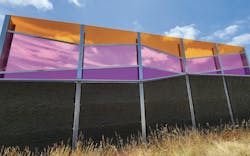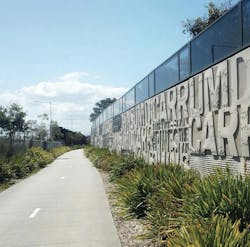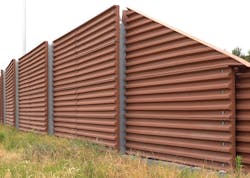By Marissa McNees
Australian manufacturer RMP Global has spent the last 15 years perfecting its sustainable infrastructure technology and, after successful installations in Australia and Europe, is introducing its recycled plastic noise walls, claddings and facades to the North American market.
RMP Global’s recycled plastic noise walls first were installed in Australia in 2009 when the contractor on a project that required about 20 panels realized how costly it would be to use concrete.
“This was kind of the moment where it sunk in how good the product was,” RMP Global President Doug Talbott says. “Then, [RMP Global] went and did more projects in Australia, and things really kind of kicked off. There was a myriad of jobs that happened.
“We even did a job in the Netherlands, who are one of the leaders in terms of infrastructure. This was really exciting as it was equivalent to exporting a pizza to Italy.”
Traditionally, noise walls have been built using concrete or steel, effectively blocking sound but doing little to resolve environmental challenges, according to RMP Global.
After many years of testing, the company developed a specialized technology to break down postconsumer plastics and remold the material into noise walls it claims can withstand the rigors of urban and transportation environments.
“Over the years, we had to do test after test after test because this is infrastructure; this is going to be up for 50 to 100 years,” Talbott says.
"The waste used in our manufacturing process is typically nonrecyclable and harmful to ecosystems, but our innovative technology repurposes it for noise barrier production. This transformative process is now poised to make a meaningful difference in North America's low-carbon infrastructure landscape."
Inside the RMP process
RMP Global employs a rotational molding system, or rotomolding, to produce its recycled noise walls.
Rotomolding involves a heated mold that is filled with powdered plastic resin. The mold is slowly rotated, dispersing the resin, which coats the inside of the mold as it is heated. The mold is rotated continuously as it cools to create the desired shape and avoid sagging and deformation.
The company uses a blend of high-density polyethylene (HDPE) from items like milk jugs and linear low-density polyethylene (LLDPE) to achieve the correct melt flow index for the plastic used in its noise walls. It buys recycled HDPE pellets as well as recovered pallet wrap, creating a blend before compounding the resulting mix into the desired color.
“We want the color to be steadfast and through properly because our products are built to last,” Talbott says.
“If you were to put a concrete panel up, you'd have a giant crane with outriggers, you'd have to have done proper ground remediation to run that crane every time you move it, you’ve got to pull the outriggers up, move the crane, set them up again,” he says. “[The recycled plastic wall] goes up at least twice the speed while using smaller, more agile equipment.”
The wall sizes vary but, on average, are approximately 4 feet tall and 10 feet wide and can be connected to support up to 24-foot post spacing. The posts used to hold the panels in place are the same used to hold concrete panels because, as Talbott explains, the posts don’t take on the weight of the panel, rather, they’re designed to withstand the wind loads.
The plastic noise walls have some design advantages, too. Talbott says the RMP panels can be made in any opaque color and can feature a different pattern on the front and back, allowing the side that faces the road, for example, to have a different look than the side that might be facing someone’s backyard or a public park. With concrete walls, one side has to be flat.
“This provides an architectural option currently not available for existing noise wall systems,” he says.
RMP noise wall molds can be customized to a specific job. Larger projects might require 10 molds, whereas smaller projects might only need one or two, for example.
The aluminum molds cost about $40,000 each and take about 12 weeks to make. Once a mold is made, however, it becomes part of the RMP Global “arsenal,” and a client can use one of these “off-the-shelf” molds to cut project costs.
To date, RMP Global has recycled the equivalent of 6.44 million milk jugs and enough pallet wrap to stretch 6,200 miles—further than Melbourne, Australia, to Hawaii.
Entry into the North American market
RMP Global introduced its recycled plastic noise walls in North America in November of last year. The success of the walls in Australia and Europe prompted the company to explore opportunities in the U.S., in particular, and Talbott says demand for noise walls is “through the roof.”
“They’re spending $500 million a year on noise walls alone,” he says of the U.S. market. “With that kind of volume, it was obvious this is where we can make the biggest difference in terms of carbon emissions.”
The RMP Global team then met with VX Group, a Cedarburg, Wisconsin-based business management consultancy that helps Australian businesses enter the North American market, and started to understand the scope of the expansion opportunities in the U.S.
The company since has come to terms on a licensing agreement with Barrier Ridge Capital, an Aurora, Ontario, investment company that seeks opportunities in the highway and road safety infrastructure space thathas provided working capital “to really kick things off over in America,” Talbott says. In November, Barrier Ridge bought 50 percent of RMP’s U.S. operations, creating a joint venture.
Along with roadside or other transportation-related applications, noise walls can be used around the perimeter of an industrial development space, and RMP Global’s first job in the U.S. is at a distribution center where it will construct and install its noise walls around the outside of the site. Other jobs provide noise protection for large construction projects to protect nearby residents from construction noise.
One factor that Talbott says has made RMP Global’s North American entry easier is that the company has contracted its manufacturing operations, partnering with Port Washington, Wisconsin-based CPI Products, a rotomolding company that manufactures solutions for the agriculture, automotive, public safety and waste management industries, among others.
“They have the right mindset, and that’s what we’re really looking for,” Talbott says of working with CPI. “It’s really important that you find the people you think you can get along with and have a similar mindset to you.”
While finding the right manufacturing partners has eased the transition, sourcing material in the U.S. has been a challenge.
In Australia, RMP Global sources mechanically recycled material, but in the U.S., Talbott has been unable to find a similar solution as recyclers in the U.S. aren’t necessarily sorting the HDPE and LLDPE grades necessary to achieve the desired blend in a clear color.
“There’s mechanically recycled HDPE, there’s mechanically recycled LDPE, but no one’s thought about saying, ‘Wait a minute, we can actually get LLPDE by blending it,” Talbott explains. “When you go to suppliers and say, ‘I want to have something for rotomolding,’ they say, ‘No, we don’t do rotomolding.’ … I think it’s more of an education piece. We want the HDPE. We want the LDPE. We’ll just bind it together.”
Once RMP Global works with enough suppliers on its specific material needs, Talbott is confident he’ll be able to source mechanically recycled plastic.
For now, the interim solution has been chemically recycled material, and because that material often is more expensive, RMP Global’s first few jobs in the U.S. feature noise walls that, for now, have a lower percentage of recycled content.
“The recycled [piece] is what’s important to me, but it’s still a significant reduction in carbon footprint by using virgin [plastic] compared to concrete,” Talbott says.
“I’m spending more because it does cost more to use chemically recycled material. In Australia, we’ve got the mechanically recycled [material] at the same price as virgin, so that’s the other reason I want to do that. The chemically recycled is definitely more expensive in the States. I don’t know where we’re going to be yet with mechanical recycling; we’ll just have to see.”
What’s next
Talbott envisions having four RMP Global manufacturing locations in the U.S.
He’s explored sites in California, Pennsylvania and Texas along with the company’s current contracted manufacturing operations in Wisconsin, prioritizing efficiency as far as transportation and logistics.
“It’s not that expensive to ship this stuff from Wisconsin to the East Coast, but I don’t want to be shipping across multiple days; I would like to keep it within a day,” Talbott says, noting that shipping across the country also is not consistent with its emissions goals, either.
“RMP global really is looking to be a global influencer and partner to organizations that are aligned to our mission, ‘Transforming waste to sustainable and cost-effective infrastructure,’ whether that's removing waste from the oceans or sustainable infrastructure and everything in between. … I think we've really been working to build relationships and cross-promote with organizations that are like-minded. It goes beyond the infrastructure.”
For more information
RMP Global, Australia (with North American headquarters in Honey Brook, Pa.), 336-978-8039, www.rmpglobal.com
About the Author
Marissa McNees
Marissa McNees is Managing Editor of Recycling Today and can be reached at [email protected]. This story was published in Plastics Recycling, a joint publication of Plastics Machinery & Manufacturing and Recycling Today.


